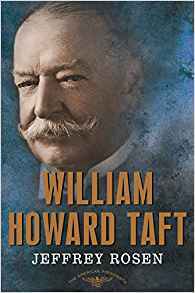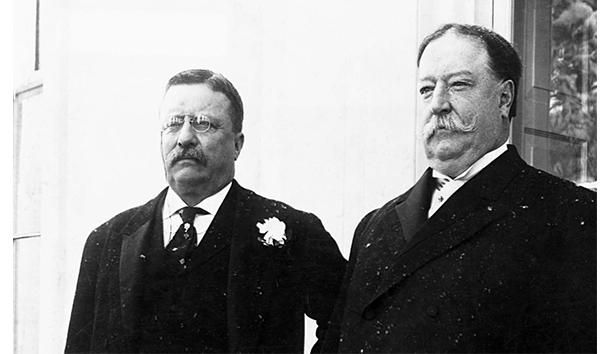In 1912, at dusk walking home, Henry Adams spotted something he thought to be a hippopotamus in the nation’s capital. As he drew nearer he saw it was President Taft.
He gave me a shock. He looks bigger and more tumble to pieces than ever . . . but what struck me most was the deterioration of his mind and expression. . . . He showed mental enfeeblement all over, and I wanted to offer him a bet that he wouldn’t get through his term.
President Theodore Roosevelt in the election of 1908 did everything in his formidable power to nominate and elect Secretary of War William Howard Taft for president. Roosevelt thought Taft the best man available to carry forward the banner of Roosevelt’s Square Deal reforms. Only 51 years old, Roosevelt left the U.S. for a year-long African safari. J.P. Morgan, expressing the sentiments of Wall Street, quipped that “America expects that every lion will do its duty.”
In this short biography, part of The American Presidents series, Rosen, a law professor at George Washington University, extols Taft for “devot[ing] his career to preserving the Constitution against the threat of populism.”
Taft’s talents were as an attorney-administrator. A far more sedate figure than Roosevelt (weighing in at 330 pounds), Taft rose to prominence through the influence of his father, Alphonso, a secretary of war and attorney general in the Grant administration. William Taft took the road of political appointment to power—federal judge, governor of the Philippines, and member of Roosevelt’s Cabinet.
In contrast, Roosevelt’s rise to power came through elective politics, serving as state representative and governor of New York. A national hero during the Spanish-American war, he became president upon the assassination of McKinley. Roosevelt loved the rough and tumble of politics. Taft loathed it. In a letter to his wife Taft called Roosevelt’s Cabinet meeting “undignified in devoting so much time to mere political discussion.”
This lack of interest in the dynamic of politics was one of Taft’s major failings. A president needs to be both administrator and politician. Theodore Roosevelt appreciated politics as an art form necessary to successful statesmanship. Like Edmund Burke, Roosevelt saw it “not as a pitiful job but as a holy function.”
Alexander Hamilton, in The Federalist, argued for a “vigour of executive authority,” which he defined as good government. Roosevelt shared this understanding. Hamilton summed up the art of political maneuvering by quoting from an oration of Demosthenes:
As the general marches at the head of his troops, so ought wise politicians . . . to march at the head of affairs; insomuch that they ought not to wait the event, to know what measures to take; but the measures which they have taken, ought to produce the event.
Taft’s administration (1909-13) was not bereft of achievement. Two amendments to the Constitution passed during his term—one for the imposition of the federal income tax and the other for direct election of United States senators. The parcel post system began with him. He extended civil service and prosecuted trusts. New Mexico and Arizona were admitted into the Union. But his record was not enough to gain him public approval.
His revision of the tariff upset the tender mechanism of the Republican Party. Republican insurgents created a further division in the party by taking away conservative House Speaker Joseph G. Canon’s considerable power, relegating him to a position of presiding officer. Taft foolishly dismissed President Garfield’s son, whom Roosevelt had appointed interior secretary. His maladroit firing of Gifford Pinchot, chief of the U.S. Forest Service and one of the founders of the conservation movement, all but destroyed party unity.
In 1910 the midterm congressional elections went decidedly against Taft. The Republican Party lost 98 seats and its majority in the House, and barely held onto it in the U.S. Senate. When Roosevelt returned to the U.S., it seemed a foregone conclusion to many that Taft would not be re-elected president.
Roosevelt was a man of action; Taft, of inaction. He waited on events and was criticized for surrounding himself with corporate lawyers. Winston Churchill summed up Taft’s folly, pointing out that “lawyers should be kept on tap, not on top!”
Taft on two occasions refused a seat on the U.S. Supreme Court offered to him by President Roosevelt. (Taft’s wife, Nellie, was ambitious for her husband to be president.) He finally accepted the nomination to Chief Justice proffered by President Harding in 1921. Rosen recognizes Taft performed better as justice than as president.
Returning to the U.S. in June 1910 after a 14-month absence, Roosevelt met with a tumultuous welcome and huge parade in New York. His friend Sen. Henry Cabot Lodge warned him to keep “a closed mouth as there is constantly growing thought of you and your return to the presidency.”
Sen. Robert La Follette had already challenged Taft for the nomination. And soon unauthorized “Roosevelt clubs” sprang up, while Roosevelt’s home at Oyster Bay lay besieged by political figures encouraging him to run. No less than seven GOP governors urged him on. Roosevelt finally threw his hat in the ring, but Taft, in control of the party machinery, succeeded in denying him the Republican nomination.
So Roosevelt formed his own Progressive Party, running under the banner of a New Nationalism that called for “initiative petition, direct election of U.S. Senators and recall.” A conservative fearful of what he called the “lunatic fringe” on the left, Roosevelt also loathed the new plutocrats of Wall Street for betraying America’s older and nobler tradition of idealism by their ruthless subordination of human life to secular economic ends. Roosevelt always sought to lift the nation’s spirit to a higher level; in 1895, he coauthored a book with Henry Cabot Lodge entitled Hero Tales From American History.
Seeing evidence of “a dreadful and vindictive radicalism” gaining ground with the Socialist candidate Eugene Debs, who was on the ballot in 1912, Roosevelt sought to channel and redirect such populist currents to conservative ends.
He hated the permanent big-government programs favored by Woodrow Wilson that would destroy the free market. His Square Deal was not a system or program, but more an expression of his personality. He used his executive power to intervene when necessary as a kind of referee, “a steward of the public welfare” ensuring fair play for all. His arbitration of the United Mine Workers coal strike in 1902 is an example of this. Roosevelt thought the chief executive should intervene to break up dishonest trusts, not large ones as Taft proposed. Roosevelt thought Taft would destroy economic competition. The rupture in the Republican Party assured the election of the Democratic presidential candidate, Woodrow Wilson, in 1912.
Rosen’s book is for the most part an evenhanded, though single-minded, evaluation of Taft as a constitutionalist president. Recent reviews of this book in the New York Times and the Wall Street Journal delighted in proclaiming Taft the antithesis of President Trump. In fact, Taft’s true nemesis is Barack Obama, who abused his constitutional powers by resorting to executive order to bypass Congress, the courts, and the Constitution.
Readers interested in a broader understanding of the turbulent times of Taft and Roosevelt would do well to consult several recent works: Jonathan Lurie’s William Howard Taft: The Travails of a Progressive Conservative; Colonel Roosevelt, by Edmund Morris; Doris Kearns Goodwin’s The Bully Pulpit; and Rick Marschall’s wonderfully edited and illustrated Bully!

[William Howard Taft: The American Presidents Series: The 27th President, 1909-1913, by Jeffrey Rosen (New York: Times Books/Henry Holt Co.) 208 pp., $26.00]

Leave a Reply